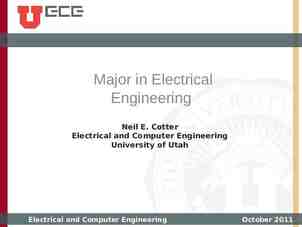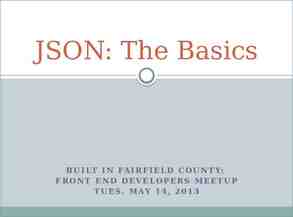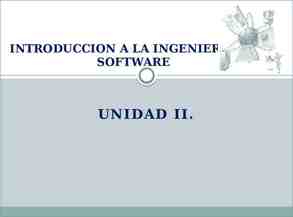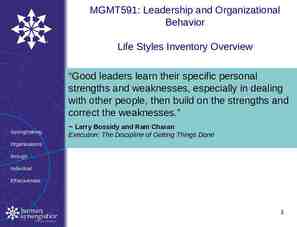Introduction to Student Affairs Theories For the Division of
19 Slides949.96 KB

Introduction to Student Affairs Theories For the Division of Student Affairs OnBoarding Developed July 2018

Cognitive - Structural Theories Definition Theories that explain how people process and understand information. This includes comparative thinking structures like classifying things, symbolic representation structures like dance and gestures, and logical reasoning structures like evaluation and problem solving. Developed July 2018

Cognitive - Structural Theories Baxter-Magolda Theory of Self-Authorship (2001) Belenky, Clinchy, Goldberger, and Tarule’s Women’s Ways of Knowing (1986) Self- authorship consists of Women’s "ways of knowing" three dimensions in which young adults create knowledge construction, develop a personal identity, and form relationships with others. The process begins in post-adolescence with actualization completed by age 30. focuses on identity and intellectual development across a broad range of contexts of women. The authors describe additional knowledge perspectives and explain gender-related influences on cognitive development in women. Developed July 2018

Learning Theories Definition Theories describe conceptual frameworks that describe how people absorb, process, and retain information during the learning process. They recognize that cognitive, emotional, environmental, and prior experiences all play a role in the learning process. Developed July 2018

Learning Theories Bloom’s Taxonomy of Learning (1956) Three domains of learning: Cognitive, Affective, Psychomotor Use this as Knowledge, Attitudes, and Skills model for designing programs and services for college students, and for supervising staff. Kolb’s Theory of Experiential Learning (1984) Looks at how one learns as an individual in relation to the development of self. Knowing what one needs to do to learn makes it easier for one to grow as a person. Developed July 2018

Person-Environment Theories Definition These theories how a person is impacted by the environment they are in. An environment that supports the desires and abilities of a person is a good fit. Arguably the most used theories in the profession. Developed July 2018

Person-Environment Theories Alexander Astin’s I-E-O Model (1985) Educational assessments must include information on student inputs (I), the educational environment (E), and student outcomes (O). This model highlights the environmental impacts on student outcomes. Maslow’s Hierarchy of Needs (1954) Students share needs common to all people. These needs go from basic (Physiological) to complex (Self-actualization). most traditional college-aged students are reaching out for new values, ideas, motivations, and purposes. Developed July 2018

Person-Environment Theories Alexander Astin’s Theory of Student Involvement (1985) Sanford Challenge & Support Theory (1962, 1966) The most basic tenet of A person needs a Astin's Theory of Involvement is that students learn more the more they are involved in both the academic and social aspects of the collegiate experience. balanced amount of challenge and support for a task. They will never learn, grow, and develop with too much support. They will become frustrated and possibly quit if challenged too much. Developed July 2018

Person-Environment Theories Unconditional Positive Regard Assumes that for healthy development, an individual needs an environment that provides genuineness, acceptance, and empathy. Unconditional positive regard therefore means valuing the person as doing their best to move forward in their lives constructively and respecting the person’s right to self-determination no matter what they choose to do. Unconditional positive regard does not mean you must like a person or approve of what they have done. Developed July 2018

Identity Theories Definition Theories that address the behaviors, emotions and thought patterns that are unique to a person. Identity can be general and unique (who am I?) or multiple (what are my identity components?). Developed July 2018

Identity Theories: General Identities Chickering and Reisser’s Theory of Identity Development (1993) An expand theory including additional research on gender, race, and nontraditional students. The resulting model identifies seven vectors that provide a comprehensive representation of the development that occurs during the collegiate years. Josselson’s Theory of Identity Development in Women (1996) Explores why some women encounter a crisis, and whether or not they integrate that into their identity. Women fit into one of four groups based on experiencing a crisis and commitment of identity. Developed July 2018

Identity Theories: Racial – Cultural Models Cross Model of Psychological Nigrescence (2010) Kim’s Asian American Identity Development Model (1981) Explains how “Blacks” A model that emphasizes come to conceptualize their racial and ethnic identity. For Black students, the process of adult nigrescence is heavily influence by the college. racial identity and external influences, such as traditional Asian family and cultural values. These areas likely affect how Asian American students see themselves as individuals, in relation to others, and their life purpose. Developed July 2018

Identity Theories: Racial – Cultural Models Torres’s Model of Hispanic Identity Development (2003) Helms’ White Racial Identity Development Model (1995) Ethnic identity is the A theory of majority maintenance of a culture. The model recognizes the influences of where one grew up, generational status, and self-perception of societal status on identity development of Latino college (Caucasian) member cultural awareness that helps explain how the majority group, by virtue of its control of the economic and cultural dimensions of our society, directly and adversely affects minority groups and itself indirectly. Developed July 2018

Identity Theories: Racial – Cultural Models Renn Ecological Model of Multiracial Identity Development (2003) Renn (2003) argued that an ecological perspective would better illustrate the development of mixed race students. Many models of identity formation for college students focus on a student’s transition through stages. Application of these stage models to minority students or those students of mixed race can be problematic because of the different types of social and environmental influences to which they are exposed. Developed July 2018

Identity Theories: LGBTQIAA Theories D’Augelli Model of Lesbian, Gay, Bisexual Development (1994) Beemyn and Rankin’s The Lives of Transgender People (2011) This model suggests Describes the development identity is influenced by one’s social environment and the support one receives while beginning to conceptualize his/her sexuality. The process is not linear, but rather a complex evolution that occurs over one’s life span. of a transgender identity. Transgender identity development is a lifespan process, allowing for a multidimensional, fluid understanding for how a person’s identity is influenced by experiences and specific contexts. Developed July 2018

Identity Theories: Faith, Religion, and Meaning Making Theory Dolaz Parks Faith Development Theory (2000) Faith as defined by Parks is, “the activity of seeking and discovering meaning in the most comprehensive dimensions of our experience” (Parks, p. 7). Parks developed four periods associated with faith development: adolescent/conventional, young adult, tested adult, and mature adult. As individuals develop they have new ways of understanding, which Parks refers to as “forms of knowing.” These forms are authoritybound, unqualified relativism, probing commitment, tested commitment, and conviction commitment. Developed July 2018

Morals, Ethics, and Personality Theories Definition Theories that address how morals. ethics, and personality are integrated to form the character of a person. Developed July 2018

Morals, Ethics, and Personality Theories Gilligan’s Theory of Women’s Moral Development (1982) Concerning moral development, men focused on rules, rights, and justice; women focused on relationships. The theory’s focus is on the relationship one has with others and how those relationships impact one’s understanding of self. Myer’s-Briggs’ Type Inventory (1985) People have preferred approaches to interaction with others and making sense of the environment. Gradually, people identify that personality types may Developed July 2018 shift slightly depending on the

References Sanford, N. (1962). The American college. New York: Wiley. Sanford, N. (1966). Self and society: Social change and individual development. New York: Atherton. Student Development Theories: A Primer, For use in the College Student Personnel Administration Program Southern Illinois University Edwardsville, Dr. Pietro Sasso, Edited in 2017 by Meagan T. Arnold Rogers, Carl. (1959). A theory of therapy, personality and interpersonal relationships as developed in the client-centered framework. In S. Koch (Ed.), Psychology: A Study of a Science. Vol. 3: Formulations of the Person and the Social Context. New York, NY: McGraw Hill. - Unconditional Positive Regard Developed July 2018






